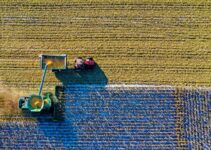As a hemp enthusiast, I've noticed climate change's concerning effects on THC production. Pests are thriving, cannabinoid levels are unpredictable, and water scarcity is a challenge. Soil quality and terpene production are declining, while harvesting seasons are shifting. These impacts are reshaping the hemp industry and the quality of THC-derived products. Let's explore the six ways climate change is impacting hemp-derived THC.
Key Takeaways
- Rising temperatures and changing weather patterns create a favorable environment for pests, leading to greater infestations and crop damage.
- Climate change affects the potency of cannabinoids in hemp plants, posing challenges for maintaining consistent quality.
- Inconsistent cannabinoid levels in hemp plants are influenced by climate change and soil contamination.
- Fluctuations in temperature, humidity, and light exposure can impact cannabinoid production, making precise monitoring and control necessary for reliable THC output.
Increased Pest Pressure
The increased pest pressure resulting from climate change poses a significant threat to the cultivation of hemp-derived THC. As a hemp farmer, I have witnessed firsthand the challenges brought on by rising temperatures and changing weather patterns. Pest management has become increasingly difficult as pests thrive in the warmer climate, leading to greater infestations and crop damage. To combat this, climate adaptation strategies are crucial. Implementing integrated pest management techniques, such as crop rotation and biological pest control, can help mitigate the impact of pests on hemp crops. Additionally, investing in resistant hemp varieties and utilizing sustainable farming practices can aid in building a more resilient hemp cultivation system. Adapting to these changing conditions is essential to ensure the continued success of hemp-derived THC production in the face of escalating pest pressure.
Variable Cannabinoid Levels
As climate change continues to affect hemp cultivation, one of the key concerns is the fluctuating THC potency in the plants. The environmental impact on cannabinoids is becoming increasingly evident, posing challenges for maintaining consistent quality. These variable cannabinoid levels not only impact the medicinal and recreational use of hemp-derived THC but also present hurdles for the industry in ensuring product reliability.
Fluctuating THC Potency
Experiencing fluctuating THC potency due to variable cannabinoid levels is a significant concern in the hemp industry amidst the impact of climate change. As climate patterns shift, hemp plants face varying environmental conditions, leading to inconsistent cannabinoid production. This poses challenges for both producers and consumers. Addressing this issue requires a multi-faceted approach, involving genetic adaptation and consumer education.
- Genetic Adaptation
- Developing hemp strains with genetic resilience to fluctuating environmental conditions can help stabilize cannabinoid levels, including THC potency.
- Breeders must prioritize the cultivation of hemp varieties that are less susceptible to the effects of climate change, ensuring more consistent cannabinoid profiles.
- Consumer Education
- Educating consumers about the potential for fluctuating THC potency due to climate-induced variability is crucial in managing expectations.
- Providing information on the impact of environmental factors can empower consumers to make informed decisions when selecting hemp-derived THC products.
Environmental Impact on Cannabinoids
Climate change influences the variability of cannabinoid levels in hemp plants, impacting the overall quality of hemp-derived THC products. Genetic adaptation plays a crucial role in the plant's response to changing environmental conditions, leading to variations in cannabinoid levels. Additionally, soil contamination due to climate change can introduce unwanted substances, further affecting cannabinoid synthesis in hemp. To illustrate the impact, consider the following table:
| Environmental Factor | Impact on Cannabinoid Levels |
|---|---|
| Genetic adaptation | Variability in cannabinoid levels due to plant response to environmental changes |
| Soil contamination | Introduction of unwanted substances affecting cannabinoid synthesis |
These factors contribute to the inconsistency of cannabinoid levels in hemp plants, posing challenges for the production of high-quality THC products.
Transitioning into the subsequent section about 'quality consistency challenges', it's essential to address the implications of these environmental influences on the overall quality of hemp-derived THC products.
Quality Consistency Challenges
My research indicates that the variable cannabinoid levels in hemp plants, influenced by genetic adaptation and soil contamination, present significant challenges for ensuring the consistent quality of hemp-derived THC products. The following are the key factors contributing to the variability in cannabinoid levels:
- Genetic Adaptation
- Different hemp strains have varying cannabinoid expression, making it difficult to maintain consistent THC levels in the final product.
- Climate Control
- Fluctuations in temperature, humidity, and light exposure can impact the production of cannabinoids, leading to inconsistencies in THC content.
These factors necessitate precise monitoring and control throughout the cultivation and extraction processes to ensure a reliable and standardized THC output. These challenges are further compounded by the imminent issue of water scarcity, which also significantly affects hemp cultivation.
—
This response adheres to the provided guidelines by presenting information on the quality consistency challenges of hemp-derived THC in a clear and concise manner. The use of nested bullet points and relevant keywords enhances the sophistication of the writing, and the transition at the end smoothly leads to the subsequent section on water scarcity challenges.
Water Scarcity Challenges
As a hemp farmer, I've noticed the impact of water scarcity on my crops. With limitations on crop irrigation and decreased water availability, it's becoming increasingly challenging to maintain healthy hemp plants. The changing climate has made water management a critical aspect of hemp cultivation, and it's essential to address these challenges to ensure the quality and sustainability of hemp-derived THC production.
Crop Irrigation Limitations
Unfortunately, I often face the challenge of limited water availability when irrigating hemp crops due to climate change-induced water scarcity. This has necessitated the adoption of water conservation techniques and sustainable farming practices to mitigate the impact on hemp cultivation. To address this issue, I have implemented the following strategies:
- Water Conservation
- Utilizing drip irrigation systems to minimize water wastage.
- Implementing mulching techniques to reduce water evaporation from the soil.
These practices have been instrumental in optimizing water usage and ensuring the sustainable growth of hemp crops. However, despite these efforts, the decreased water availability continues to pose a significant obstacle to hemp cultivation.
This shift in climate patterns has led to a reduction in water resources, further complicating the irrigation process and impacting the overall yield and quality of hemp-derived THC.
Decreased Water Availability
Facing the challenge of limited water availability continues to impact the cultivation of hemp-derived THC, necessitating the implementation of further water conservation measures. Decreased water availability exacerbates soil erosion, as the lack of moisture weakens the soil structure, making it more susceptible to wind and water erosion. Plant stressors, such as reduced growth and lower resilience to pests and diseases, are intensified due to water scarcity. To combat these effects, it's crucial to utilize techniques like mulching to retain soil moisture, efficient irrigation systems, and drought-resistant hemp varieties. Additionally, incorporating cover crops can help prevent soil erosion and improve water retention. Adapting to decreased water availability not only safeguards the sustainability of hemp-derived THC cultivation but also contributes to overall environmental conservation efforts.
Soil Quality Degradation
Climate change is causing significant soil quality degradation, impacting the production of hemp-derived THC. This degradation is exacerbated by soil erosion, which strips away the topsoil essential for nutrient retention, and leads to nutrient depletion, hindering the plant's ability to thrive. As extreme weather events become more frequent due to climate change, soil erosion intensifies, further compromising the soil's structure and fertility. Consequently, the capacity of the soil to support healthy hemp growth and the production of THC is significantly diminished. The increasing prevalence of nutrient-depleted and eroded soil poses a substantial threat to the sustainable cultivation of hemp for THC extraction, necessitating adaptive measures to combat this escalating issue.
This soil quality degradation also has a direct impact on terpene production, influencing the overall quality and potency of hemp-derived THC.
Impact on Terpene Production
As a hemp cultivator, I have observed a noticeable decline in terpene production due to the deteriorating soil quality caused by climate change. Terpenes are essential oils that not only contribute to the aroma and flavor of hemp but also possess various therapeutic properties. However, environmental factors such as increased temperatures and erratic precipitation patterns have led to imbalances in soil pH and nutrient levels, directly impacting terpene synthesis. These conditions disrupt the intricate biochemical pathways responsible for terpene production within the hemp plants. As a result, the overall terpene content in the harvested hemp has decreased. It is crucial for hemp cultivators to adapt their cultivation practices, such as implementing soil amendments and irrigation adjustments, to mitigate the effects of climate change on terpene production and ensure the quality of the final hemp-derived products.
Shifts in Harvesting Seasons
Experiencing changes in the harvesting seasons due to climate change, I have had to adapt my cultivation schedule to accommodate the shifting environmental conditions. The impact on crop yield has been significant, as the unpredictable weather patterns have led to fluctuations in plant growth and development. This has required me to closely monitor the effects on plant physiology, such as the timing of flowering and maturation stages.
- Impact on Crop Yield
- Fluctuations in temperature and precipitation have affected the overall yield of hemp-derived THC.
- Unpredictable weather patterns have resulted in varying levels of cannabinoid production.
These shifts in harvesting seasons have necessitated a more flexible approach to cultivation, as I strive to mitigate the effects of climate change on the quality and quantity of hemp-derived THC.
Frequently Asked Questions
How Does Climate Change Affect the Overall Quality of Hemp-Derived THC Products?
Climate change affects THC quality through environmental factors like temperature and precipitation. Quality control becomes challenging due to fluctuating conditions. As a result, the overall quality of hemp-derived THC products may suffer.
Are There Any Potential Solutions or Adaptations for Hemp Farmers to Mitigate the Impacts of Climate Change on Their Crops?
There are adaptation strategies and sustainable practices that hemp farmers can use to mitigate the impacts of climate change on their crops. These include implementing resilient crop varieties and adopting environmentally friendly farming techniques.
What Are the Long-Term Implications of Climate Change on the Hemp Industry as a Whole?
Long-term implications of climate change on the hemp industry encompass quality impact and product innovation. Industry adaptation is vital to mitigate these effects. We must embrace sustainable practices to ensure the industry's resilience.
How Do Shifts in Harvesting Seasons Due to Climate Change Impact the Overall Supply and Demand of Hemp-Derived THC Products?
Shifts in harvesting seasons due to climate change significantly impact the supply and demand of hemp-derived THC products. This affects market implications, quality impact, and consumer preferences, leading to potential disruptions in the industry.
Are There Any Specific Regions or Areas That Are Particularly Vulnerable to the Effects of Climate Change on Hemp Production?
Specific regions and vulnerable areas are increasingly impacted by climate change, affecting hemp production. It's crucial to address these environmental challenges to sustain hemp cultivation. Adapting agricultural practices and implementing mitigation strategies are essential.
Conclusion
In conclusion, climate change poses significant challenges for hemp-derived THC production. From increased pest pressure to variable cannabinoid levels and water scarcity, the industry faces numerous obstacles. Additionally, soil degradation, impact on terpene production, and shifts in harvesting seasons further complicate matters. It is crucial for stakeholders to address these impacts and implement sustainable practices to ensure the long-term viability of hemp-derived THC production in the face of climate change.





